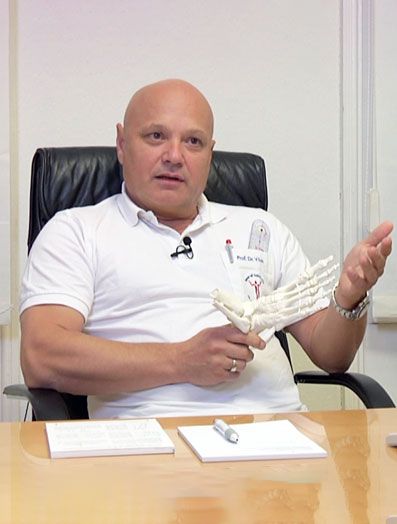Tumors
There are also benign and malignant tumors which can affect the feet.
Malignant tumors are very rare, but they must be considered when diagnosing a swelling. The conventional X-ray, and especially the MRI, the CT and in any case, a blood sample are most helpful.
Here are a few examples, selected from a wide range of possible benign and malignant tumors:
Tendon hygroma
In case of overuse, rheumatism, gout, diabetes and other metabolic diseases but also due to other unknown cause, the numerous large tendons of the hindfoot can also develop a swelling of their sheets. If conservative treatment (physical measures, decongestant medicines, insoles) fails, the swelling can be surgically removed. The prognosis is good.
The arrows show the swelling of the so-called peroneus tendon of a patient and the MRI result.
We removed the swelling surgically. Since the short tendon was already very weak, it was sutured to the long peroneus tendon and thus strengthened. The patient was symptom-free after a short time.
Ganglion
Ganglia are outgrowths of the joint capsule, and they can actually affect any joint.
Cells of the synovial membrane suddenly produce more mucus than necessary. This gellatinous liquid is then pushed outwards due to lack of space, and also appears as a filled swelling. The swelling is sometimes so hard that patients feel they have got a ganglion. This new formation is absolutely harmless and is removed only if pain or shoe pressure occurs or if it otherwise disturbs the patient.
Just as with similar operations on the hand, it is important to remove the slime-forming stem, otherwise the ganglion may come back.
A giant ganglion at the ankle (arrows).
After removal, the patient is pain-free, and the tumor did not come back.
Benign bone tumors
This large bone cyst consisted of adipose tissue (intraosseous lipoma). The patient complained of pain, and there was danger of a collapse, as the tumor had displaced the bone tissue.
The tumor was cleared, the sclerosed (hardened) cyst wall was opened and the cavity filled with artificial bone. For stabilization a low profile heel bone plate was mounted. The artificial bone connected very well with the rest of the bones and the cyst was healed completely.
X-ray images, and especially the CT show the extent of this large tumor.
In the OP picture you can see the final state after the removal, the artificial filling and the plating.
After 8 weeks the X-ray shows the complete integration of the artificial bone into the natural bone.
Lipoma
Lipomas are benign adipose tissue tumors. They can occur anywhere, although not often at the feet. If they disturb, as in our example, they are removed surgically.
A comparatively large lipoma, which had long been disturbing. You can see the damage caused to the bone by the long pressure of the circular crop.
The removal was relatively tedious.
Osteosarcoma
A highly malignant bone tumor that is fortunately rare. Unfortunately, the patient had it examined very late and also did not want a surgery. I never saw him again.
An appeal: Please consult a doctor in any case!
They are usually harmless, but a check-up may perhaps save your leg or even your life!
Another tumor
This is supposedly only a tumor. It is a so-called gangrene. The patient is diabetic and was not paying attention to his feet. Diabetics often do not feel their feet and therefore notice a bruising or (infected) ulcers very late, or not at all.
The second toe had to be amputated in this case.
Another appeal: Diabetes patients must take care of their feet a lot.
They should regularly get professional, trained foot care, and show even the smallest wounds to the doctor! They need orthopedic shoe inserts and not very uncommonly orthopedic shoes as well.



